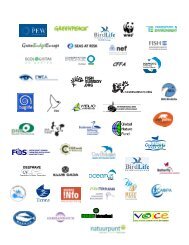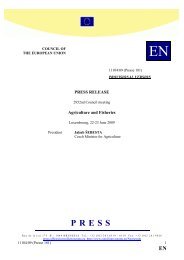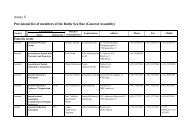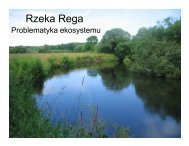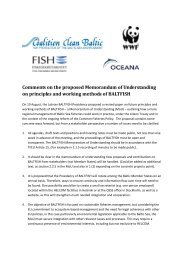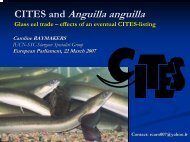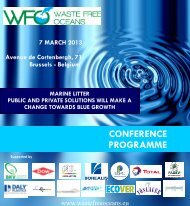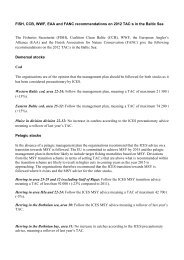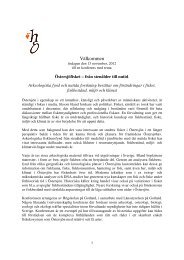A report on iUU fishing of Baltic Sea cod - Fisheries Secretariat
A report on iUU fishing of Baltic Sea cod - Fisheries Secretariat
A report on iUU fishing of Baltic Sea cod - Fisheries Secretariat
Create successful ePaper yourself
Turn your PDF publications into a flip-book with our unique Google optimized e-Paper software.
Small scale Pelagic Demersal Staticcoastal trawler trawlers gear3,27 63 3 57Source: FAO, 2005Many <strong>of</strong> the trawlers use both pelagic anddemersal trawls for herring. Pelagic trawls are<strong>of</strong>ten used to exploit the juvenile herring stocks,whereas demersal trawling is directed more tothe adult part <strong>of</strong> the stock. Only a few vesselsdirectly exploit sprat. However, sprat is the mainbycatch in the herring fishery (ICES, 2005). Ninetyper cent <strong>of</strong> the total catch is <strong>Baltic</strong> herringor sprat. Almost all the sprat and three quarters<strong>of</strong> the <strong>Baltic</strong> herring is used for reducti<strong>on</strong> orotherwise as animal feed, leaving less than <strong>on</strong>ethird <strong>of</strong> the total catch for human c<strong>on</strong>sumpti<strong>on</strong>(FAO, 2005).A few vessels target <strong>cod</strong> with demersal trawls inthe Main Basin (SDs 24-25) as do a small number<strong>of</strong> gillnetters (FAO, 2005).Main species 1995 1996 1997 1998 1999Cod ,181 1,388 1,425 1,201 1,168*Herring 31,400 31,500 23,700 24,800 17,900Sprat 5,200 17,400 24,400 25,700 18,900Main species 2000 2001 2002 2003 2004Cod 775 856 228 650 1,193*Herring 23,300 26,100 25,700 14,700 14,500Sprat 20,200 15,400 17,200 9,000 18,600*preliminarySource: ICES 2005A coastal trap net fishery for herring, salm<strong>on</strong> andEuropean whitefish (Coreg<strong>on</strong>idae) is comm<strong>on</strong>near the coast and inside archipelagos (FAO,2005).The processing sectorThere are a few large processing plants and numeroussmall family businesses. There were 228processing plants in 2001. They mostly processeddomestically landed fish (approximately 35,000t<strong>on</strong>nes), but also around 6,000 t<strong>on</strong>nes <strong>of</strong> importedfish (FAO, 2005).Over half <strong>of</strong> the <strong>Baltic</strong> herring used for humanc<strong>on</strong>sumpti<strong>on</strong> is deep frozen, whereas half <strong>of</strong> therainbow trout is c<strong>on</strong>sumed in the form <strong>of</strong> fillets.The majority <strong>of</strong> fish for human c<strong>on</strong>sumpti<strong>on</strong> isprocessed into fillets; deep-frozen fish are thesec<strong>on</strong>d most frequently c<strong>on</strong>sumed form <strong>of</strong> fish(OECD, 2005b).ESTONIA<strong>Fisheries</strong> do not play a significant role in theEst<strong>on</strong>ian ec<strong>on</strong>omy, c<strong>on</strong>tributing about 0.3% tothe GDP. It is <strong>of</strong> ec<strong>on</strong>omic, social and culturalimportance in coastal areas where alternativeincome sources are scarce. <strong>Fisheries</strong> employmentis c<strong>on</strong>centrated in the western part <strong>of</strong> Est<strong>on</strong>ia,the islands al<strong>on</strong>g the west coast and the coast <strong>of</strong>the Gulf <strong>of</strong> Finland (EU Commissi<strong>on</strong>, 2004). Approximately2,300 people were employed in the<strong>fishing</strong> industry in 2003 (FAO, 2005a).In 2004 the Est<strong>on</strong>ian <strong>Baltic</strong> <strong>Sea</strong> <strong>fishing</strong> fleetc<strong>on</strong>sisted primarily <strong>of</strong> trawlers: 152 <strong>fishing</strong> vessels<strong>of</strong> over 12 m and 888 vessels <strong>of</strong> under 12 m.The fishery is predominantly focused <strong>on</strong> herringand sprat. Pelagic trawls take the most significantproporti<strong>on</strong> <strong>of</strong> the catch but pound net fisheriesin the Gulf <strong>of</strong> Riga can also take large amounts.Cod is all but absent from the Est<strong>on</strong>ian EEZ soa limited amount <strong>of</strong> <strong>fishing</strong> is undertaken by gillnetters in the Main Basin (SD 25) to the east.Brackish water fishes like perch, pike-perch,flounder, eel, sea trout and salm<strong>on</strong> being targetedby passive <strong>fishing</strong> gear is mainly used in coastalfisheries (ICES, 2005; FAO, 2005a). The Tablebelow shows the <str<strong>on</strong>g>report</str<strong>on</strong>g>ed quantities <strong>of</strong> the mainspecies <strong>of</strong> fish in metric t<strong>on</strong>nes landed by theEst<strong>on</strong>ian fleet.Main species 1995 1996 1997 1998 1999Cod 1,049 1,388 1,420 1,196 1,062Herring 30,700 35,700 42,600 34,000 35,400Sprat 13,100 21,100 38,900 32,300 33,200Main species 2000 2001 2002 2003 2004Cod 609 805 37 591 1,193*Herring 30,100 27,400 21,00 13,300 10,900*Sprat 39,400 37,500 41,300 29,200 30,200* preliminarySource: ICES, 2005Est<strong>on</strong>ia has a distant-water <strong>fishing</strong> fleet whichc<strong>on</strong>sists <strong>of</strong> 11 factory trawlers – a shadow <strong>of</strong> itsformer self. Shrimp from the NAFO and NEAFCregulatory areas is the main target species. Themain export destinati<strong>on</strong>s for the shrimp pro-– 55 –



